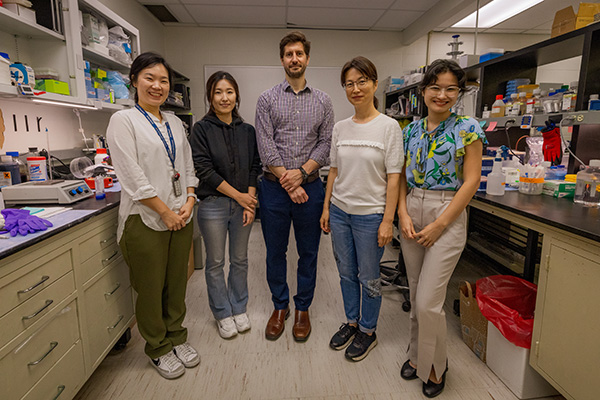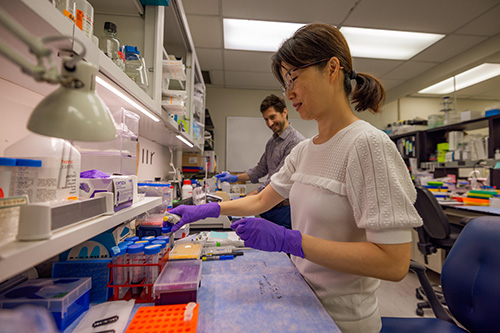Will Erwin Headache Research Center (WEC)
OVERVIEW
The Will Erwin Headache Research Center, led by Dr. Mark Burish, aims to understand the mechanisms underlying headache and facial pain disorders. Progress in the research of many of these disorders has been limited by the lack of diagnostic tests, few good animal models, and the rarity of many of the diseases. At the same time, a wide range of new devices and antibody-targeted drugs has opened up the possibility of many new treatment options. Our focus is clinical research, in studying patients. We study the molecular and physiological basis of these diseases, and hope to provide a link to basic science research and treatment trials for them.
The Will Erwin Headache Research Center is associated with the Will Erwin Headache Research Foundation, a non-profit organization with the goal of finding cures for debilitating headaches. For more details on the work of the Will Erwin Headache Research Foundation, click here.
Leadership
Dr. Mark Burish, MD, PHD, is an associate professor in the Vivian L. Smith Department of Neurosurgery at the McGovern Medical School at UTHealth Houston, where he also serves as a neurologist and interventional pain specialist. He obtained his MD and PhD at Vanderbilt University, where his research focused on brain mapping of motor and somatosensory systems including studies on how the central nervous system adapts after injury.
is an associate professor in the Vivian L. Smith Department of Neurosurgery at the McGovern Medical School at UTHealth Houston, where he also serves as a neurologist and interventional pain specialist. He obtained his MD and PhD at Vanderbilt University, where his research focused on brain mapping of motor and somatosensory systems including studies on how the central nervous system adapts after injury.
His neurology and pain management training was at the University of California at San Francisco, where his treatment of patients led to an interest in headache and pain. He is currently collaborating with Dr. Seung-Hee Yoo and her team at McGovern Medical School for ongoing headache research.
For a full list of Dr. Burish’s publications, click here.
Clinical research (research with patients)
Cluster headache:
- Online treatment survey in collaboration with Clusterbusters
- Phone call and online survey: headache registry of patients with trigeminal autonomic cephalalgias including cluster headache
Cluster headache is also known as suicide headache or Horton’s syndrome. The intensity of the pain is suspected to among the worst that humans can experience. It is part of the trigeminal autonomic cephalalgia (TAC) group of headaches, which are a group of primary headache disorders characterized by one-sided forehead or eye pain that is usually accompanied by ipsilateral cranial autonomic features like a red eye, watery eye, droopy eyelid, runny nose, or nasal congestion. The headache is known for its “clock-like” predictability, and we have been studying that clock-like pattern in our collaboration with Dr. Seung-Hee Yoo and her team.
Hemicrania Continua:
Hemicrania continua is characterized by constant pain on one side of the head that, when it flares up, is usually accompanied by ipsilateral cranial autonomic features like a red eye, watery eye, droopy eyelid, runny nose, or nasal congestion. Hemicrania continua responds very well to treatment with indomethacin. It is a rare headache and is also part of the trigeminal autonomic cephalalgia (TAC) group of headaches.
Paroxysmal Hemicrania:
Paroxysmal hemicrania is characterized by sudden, brief, reoccurring, and high-frequency (5 or more episodes a day) attacks on one side of the head. It is also characterized by one-sided forehead or eye pain that is usually accompanied by ipsilateral cranial autonomic features like a red eye, watery eye, droopy eyelid, runny nose, or nasal congestion. It is a rare headache and is also part of the trigeminal autonomic cephalalgia (TAC) group of headaches.
SUNCT or SUNA (Short-Lasting Unilateral Neuralgiform Headache with Conjunctival Injection and Tearing or Short-Lasting Unilateral Neuralgiform Headache Attacks with Cranial Autonomic Symptoms):
SUNCT and SUNA are two different types of headaches that are characterized by brief one-sided head pain in the forehead, cheek, and/or chin on one side. The pain can often be triggered by touching the area and is usually accompanied by ipsilateral cranial autonomic features like a red eye, watery eye, droopy eyelid, runny nose, or nasal congestion. It has features similar to trigeminal neuralgia (a different type of pain), but SUNCT and SUNA have the changes on the face (like the red eye or runny nose) that are not present with trigeminal neuralgia. It is a rare headache and is also part of the trigeminal autonomic cephalalgia (TAC) group of headaches.
Preclinical research (non-human research)
To see our UTHealth Houston Circadian Rhythms of Pain page, please click here »
Our Team

Clinical Research
- Leadership: Mark J. Burish
- Leadership: Seung-Hee “Sally” Yoo
- Team member: Celia K. Tran
Preclinical Research
- Leadership: Seung-Hee “Sally” Yoo
- Leadership: Mark J. Burish
- Collaborator: Zheng “Jake” Chen
- Team member: Chorong Han
- Team member: Hwayoung Baek
- Team member: Kaori Ono
UTHealth Houston Circadian Rhythms of Pain
Our biological clock controls the rhythm of many processes in our body including our 24-hour fluctuations in alertness, blood pressure, and many other physiological processes. Pain is one of the processes that has a 24-hour pattern. Some pain disorders are remarkably circadian such as cluster headache, where some patients will have cluster headaches every night at 2 AM for several weeks regardless of where they are in the world. We therefore are interested in how these circadian changes start at the molecular level and cause behavioral
changes.
Our research effort consists of a basic science laboratory and a clinical headache laboratory and uses the following techniques to study the circadian features of pain:
Research with humans (translational research)
- Whole genome sequencing
- RNA sequencing
- ELISA
Research with rodent and cell lines
- Animal pain models
- Circadian behavioral models
- RNA sequencing
- qPCR and ELISA
- Immunohistochemistry
- Bioluminescence recordings
- Pharmacologic studies using human treatments
For more of our human clinical trials and epidemiology studies please see our Will Erwin Headache Research Center page.
Publications
To view our team’s publications, please click here »
Contact Us
The Will Erwin Headache Research Center is located at the Memorial Hermann Plaza Building at 6400 Fannin, Suite 2010, Houston TX. It is located within the Texas Medical Center (on the north side near the Houston Zoo and Hermann Park).
For more information: Please call the research office at (713) 486-7771 or email [email protected].
